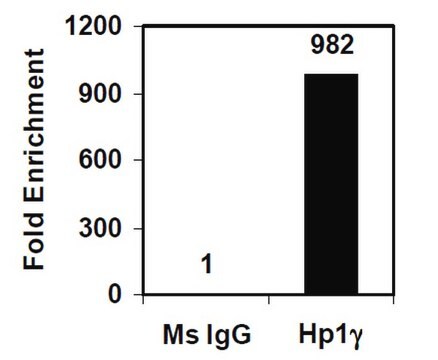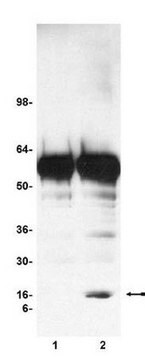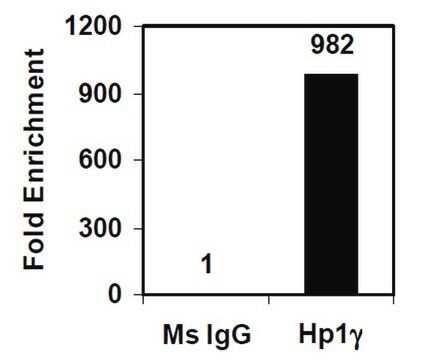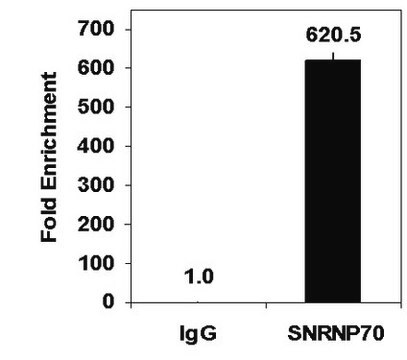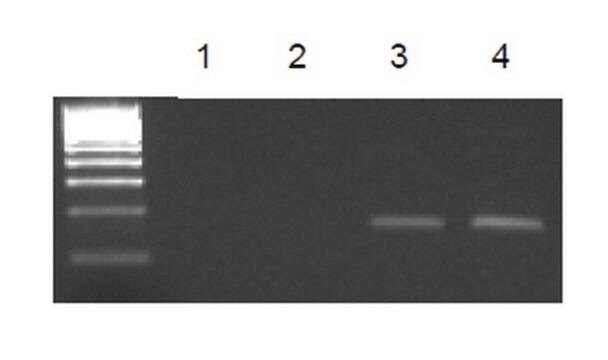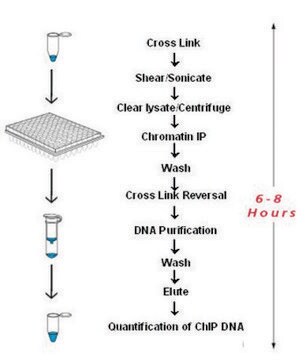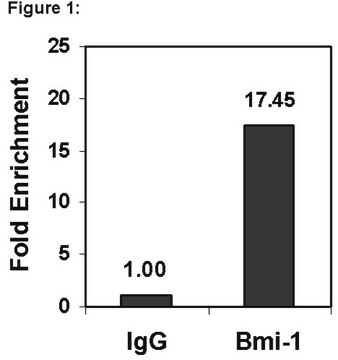17-408
EZ-Magna ChIP® A - Zestaw do immunoprecypitacji chromatyny
Single day chromatin immunoprecipitation (ChIP) kit containing all necessary reagents to perform 22 individual chromatin immunoprecipitation (ChIP) reactions using magnetic A beads. Control primers included.
Synonim(y):
Immunoprecypitacja chromatyny magnetycznej, Magnetyczny zestaw ChIP
Zaloguj sięWyświetlanie cen organizacyjnych i kontraktowych
About This Item
Kod UNSPSC:
12161503
eCl@ss:
32161000
NACRES:
NA.52
Polecane produkty
Poziom jakości
producent / nazwa handlowa
Magna ChIP®
metody
immunoprecipitation (IP): suitable
Warunki transportu
dry ice
Opis ogólny
Chromatin Immunoprecipitation (ChIP) is a powerful technique for mapping the in vivo distribution of proteins associated with chromosomal DNA. These proteins can be histone subunits and post-translational modifications or other chromatin associated proteins such as transcription factors, chromatin regulators, etc. Additionally, ChIP can be used to identify regions of the genome associated with these proteins, or conversely, to identify proteins associated with a particular region of the genome. ChIP methodology often involves protein-DNA and protein-protein cross-linking, fragmentation of the cross-linked chromatin, and subsequent immunoprecipitation of chromatin with an antibody specific to a target protein. The DNA fragments isolated in complex with the target protein can be identified by a variety of methods including PCR, DNA microarray and DNA sequencing. Standard or quantitative PCR can be performed to verify whether a particular DNA sequence (the gene or region of the genome) is associated with the protein of interest. The combination of ChIP and promoter or genomic tiling microarrays (ChIP-chip) allows genome-wide identification of DNA-binding sites for chromatin-associated proteins with precise resolution. Alternatively, high-throughput sequencing of libraries constructed from immunoprecipitated chromosomal DNA (ChIP-Seq) is a powerful alternative to ChIP-chip in mapping the protein-DNA interactions across mammalian genomes.
Chromatin Immunoprecipitation (ChIP) is an important technique allowing the researcher to analyze in vivo interactions of proteins with genomic DNA. Any chromatin-associated or DNA binding protein can be analyzed with this technique, provided a good antibody to the protein exists. One can measure different proteins localized to a specific region of the genome, or the genome wide distribution of a specific protein. Another powerful application of this technique is to analyze changes in histone modifications that correlate with processes like transcription, mitosis or DNA repair.
Features & Benefits:
Faster: Magnetic protein A beads allow for the entire ChIP protocol to be done in as little as a day! All reagents to process your samples are included - you don′t have to spend valuable time making them.
Easier: Spin columns make DNA purification easier and more reliable - no more messy phenol-chloroform extractions.
Greater Reproducibility: Positive and negative control antibodies and PCR primers are included to help validate your results and to troubleshoot your experiments.
Features & Benefits:
Faster: Magnetic protein A beads allow for the entire ChIP protocol to be done in as little as a day! All reagents to process your samples are included - you don′t have to spend valuable time making them.
Easier: Spin columns make DNA purification easier and more reliable - no more messy phenol-chloroform extractions.
Greater Reproducibility: Positive and negative control antibodies and PCR primers are included to help validate your results and to troubleshoot your experiments.
Zastosowanie
Used to detect/quantify: Protein A
Opakowanie
Kit capacity: 22 chromatin immunoprecipitation assays
Komponenty
Magnetic Protein A beads
ChIP Dilution Buffer
Low Salt Wash Buffer
High Salt Wash Buffer
LiCl Wash Buffer
TE Buffer
Cell Lysis Buffer
Nuclear Lysis Buffer
ChIP Elution Buffer (w/o Proteinase K)
10X Glycine
10X PBS
Protease Inhibitor Cocktail II
Proteinase K
Control Primers
Anti-Acetyl Histone H3
Normal Rabbit IgG
Spin Filters
Collection Tubes
Bind Reagent A
Wash Reagent B
Elution Reagent C
ChIP Dilution Buffer
Low Salt Wash Buffer
High Salt Wash Buffer
LiCl Wash Buffer
TE Buffer
Cell Lysis Buffer
Nuclear Lysis Buffer
ChIP Elution Buffer (w/o Proteinase K)
10X Glycine
10X PBS
Protease Inhibitor Cocktail II
Proteinase K
Control Primers
Anti-Acetyl Histone H3
Normal Rabbit IgG
Spin Filters
Collection Tubes
Bind Reagent A
Wash Reagent B
Elution Reagent C
Postać fizyczna
Two boxes containing all necessary reagents to perform 22 individual chromatin immunoprecipitation (ChIP) reactions. Supplied buffers are sufficient to generate chromatin from up to five 15 cm plates of cultured cells, each plate providing up to 10 chromatin preparations (varies with cell and assay type).
Przechowywanie i stabilność
Upon receipt, store components at the temperatures indicated on the labels. Kit components are stable for 1 year from date of shipment when stored as directed.
Informacje prawne
MAGNA CHIP is a registered trademark of Merck KGaA, Darmstadt, Germany
Oświadczenie o zrzeczeniu się odpowiedzialności
Unless otherwise stated in our catalog or other company documentation accompanying the product(s), our products are intended for research use only and are not to be used for any other purpose, which includes but is not limited to, unauthorized commercial uses, in vitro diagnostic uses, ex vivo or in vivo therapeutic uses or any type of consumption or application to humans or animals.
Ta strona może zawierać tekst przetłumaczony maszynowo.
Hasło ostrzegawcze
Danger
Zwroty wskazujące rodzaj zagrożenia
Zwroty wskazujące środki ostrożności
Klasyfikacja zagrożeń
Acute Tox. 4 Oral - Aquatic Chronic 3 - Eye Irrit. 2 - Flam. Liq. 2 - Skin Irrit. 2
Kod klasy składowania
3 - Flammable liquids
Temperatura zapłonu (°F)
55.4 °F
Temperatura zapłonu (°C)
13 °C
Certyfikaty analizy (CoA)
Poszukaj Certyfikaty analizy (CoA), wpisując numer partii/serii produktów. Numery serii i partii można znaleźć na etykiecie produktu po słowach „seria” lub „partia”.
Masz już ten produkt?
Dokumenty związane z niedawno zakupionymi produktami zostały zamieszczone w Bibliotece dokumentów.
Ting Xu et al.
Cellular oncology (Dordrecht), 43(2), 297-310 (2019-12-31)
Long non-coding RNAs (lncRNAs) are known to be frequently dysregulated in many types of human cancer. As yet, however, their roles in colon carcinogenesis have not been fully elucidated. In the current study, we assessed whether lncRNA LINC00858 may be
Bone morphogenetic protein signaling in vascular disease: anti-inflammatory action through myocardin-related transcription factor A.
Wang, D; Prakash, J; Nguyen, P; Davis-Dusenbery, BN; Hill, NS; Layne, MD; Hata, A; Lagna, G
The Journal of Biological Chemistry null
IRF-1 transcriptionally upregulates PUMA, which mediates the mitochondrial apoptotic pathway in IRF-1-induced apoptosis in cancer cells.
Gao, J; Senthil, M; Ren, B; Yan, J; Xing, Q; Yu, J; Zhang, L; Yim, JH
Cell Death and Differentiation null
Characterization of the activation of protein tyrosine phosphatase, receptor-type, Z polypeptide 1 (PTPRZ1) by hypoxia inducible factor-2 alpha.
Wang, V; Davis, DA; Veeranna, RP; Haque, M; Yarchoan, R
Testing null
Songjun Xu et al.
PloS one, 11(7), e0159623-e0159623 (2016-07-28)
Environmental enrichment (EE) conditions have beneficial effects for reinstating cognitive ability in neuropathological disorders like Alzheimer's disease (AD). While EE benefits involve epigenetic gene control mechanisms that comprise histone acetylation, the histone acetyltransferases (HATs) involved remain largely unknown. Here, we
Nasz zespół naukowców ma doświadczenie we wszystkich obszarach badań, w tym w naukach przyrodniczych, materiałoznawstwie, syntezie chemicznej, chromatografii, analityce i wielu innych dziedzinach.
Skontaktuj się z zespołem ds. pomocy technicznej